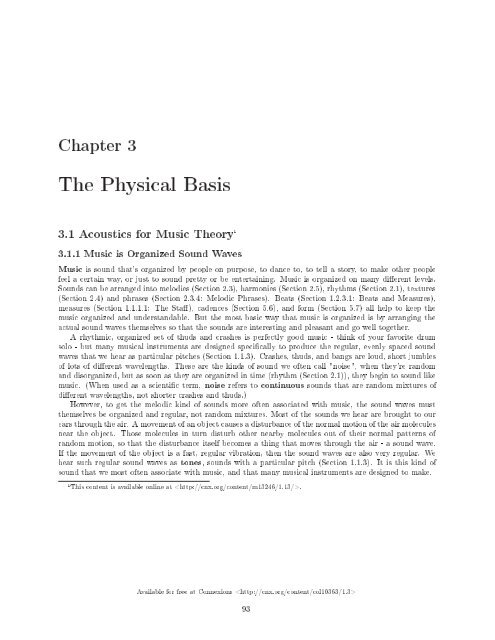Understanding Basic Music Theory, 2013a
Understanding Basic Music Theory, 2013a
Understanding Basic Music Theory, 2013a
Create successful ePaper yourself
Turn your PDF publications into a flip-book with our unique Google optimized e-Paper software.
Chapter 3<br />
The Physical Basis<br />
3.1 Acoustics for <strong>Music</strong> <strong>Theory</strong> 1<br />
3.1.1 <strong>Music</strong> is Organized Sound Waves<br />
<strong>Music</strong> is sound that's organized by people on purpose, to dance to, to tell a story, to make other people<br />
feel a certain way, or just to sound pretty or be entertaining. <strong>Music</strong> is organized on many dierent levels.<br />
Sounds can be arranged into melodies (Section 2.3), harmonies (Section 2.5), rhythms (Section 2.1), textures<br />
(Section 2.4) and phrases (Section 2.3.4: Melodic Phrases). Beats (Section 1.2.3.1: Beats and Measures),<br />
measures (Section 1.1.1.1: The Sta), cadences (Section 5.6), and form (Section 5.7) all help to keep the<br />
music organized and understandable. But the most basic way that music is organized is by arranging the<br />
actual sound waves themselves so that the sounds are interesting and pleasant and go well together.<br />
A rhythmic, organized set of thuds and crashes is perfectly good music - think of your favorite drum<br />
solo - but many musical instruments are designed specically to produce the regular, evenly spaced sound<br />
waves that we hear as particular pitches (Section 1.1.3). Crashes, thuds, and bangs are loud, short jumbles<br />
of lots of dierent wavelengths. These are the kinds of sound we often call "noise", when they're random<br />
and disorganized, but as soon as they are organized in time (rhythm (Section 2.1)), they begin to sound like<br />
music. (When used as a scientic term, noise refers to continuous sounds that are random mixtures of<br />
dierent wavelengths, not shorter crashes and thuds.)<br />
However, to get the melodic kind of sounds more often associated with music, the sound waves must<br />
themselves be organized and regular, not random mixtures. Most of the sounds we hear are brought to our<br />
ears through the air. A movement of an object causes a disturbance of the normal motion of the air molecules<br />
near the object. Those molecules in turn disturb other nearby molecules out of their normal patterns of<br />
random motion, so that the disturbance itself becomes a thing that moves through the air - a sound wave.<br />
If the movement of the object is a fast, regular vibration, then the sound waves are also very regular. We<br />
hear such regular sound waves as tones, sounds with a particular pitch (Section 1.1.3). It is this kind of<br />
sound that we most often associate with music, and that many musical instruments are designed to make.<br />
1 This content is available online at .<br />
Available for free at Connexions <br />
93


















